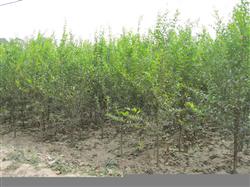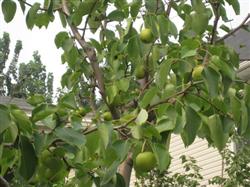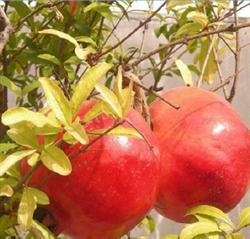Cultivation techniques of young pomegranate

Pomegranate is an important economic tree species in mountain area because of its light-loving, drought-resistant, barren-tolerant, early fruiting and easy management. In the young stage, we should pay attention to the following cultivation measures: first, the selection of improved varieties and strong seedlings 1, the selection of excellent varieties of pomegranate can be divided into sweet, sour, sour and sweet, if there is no special need, the cultivation of sweet pomegranate is the main culture. the main excellent varieties are Dahongpao, green skin sweet, white skin sweet, red skin sweet and so on. 2. The cultivation of pomegranate seedlings can be divided into two ways: root tillering seedlings and cutting seedlings. Because of the different growth environment, the growth and sturdiness of root tiller seedlings are quite different, and there are fewer fibrous roots. therefore, when using root tiller seedlings to build a garden, it is best to cut them short and cultivate them in the nursery after planing, and then replant in the second year, which can improve the survival rate and ensure the healthy growth in the first year after planting. Cutting seedlings in winter cut sturdy annual branches, cut into 20 cm cuttings, wet sand storage. Select the seedling site at the end of March and the beginning of April, apply sufficient basic fertilizer, straighten out the seedling bed, take out the cuttings in early April, soak them in clean water for 24 hours, let the cuttings fully absorb water, obliquely insert them into the finished border, expose the ground by 2cm, and then water them. After the water seeps down, it is covered with sand, covering the upper end and covering the plastic film. After emergence, according to the growth status of seedlings, timely fertilization and watering. Active cuttings should be avoided in the early stage so as not to affect survival, and proper water control should be carried out in the later stage to ensure that the seedlings are sturdy and full. Second, fine planting 1. Before improving the soil, it is necessary to turn deeply and expand the hole and apply enough organic fertilizer. The suitable distance of planting rows is 5 meters × 3 meters, and the planting distance of Weir side is 3 meters. The place with better light should be selected as far as possible. 2. The pollinated variety pomegranate is cross-flower and fruiting, and the ratio of main varieties to pollinated varieties is at least 3:1. The above varieties can be pollinated with each other. 3. Suitable late planting pomegranate is easy to strip in early spring, so it is necessary to plant pomegranate in early April when the ground temperature rises above 10 ℃. After planting, the tree plate is covered with plastic film, the temperature is increased, the soil moisture is preserved, the slow seedling period is shortened, and the survival rate is improved. 4. Pick the heart to promote the strong planting in July and August of the same year, pick the heart, promote the branching, and promote the lower part to be stout. After the arrival of the rainy season in July, it is necessary to control the water, prevent the branches from growing and prevent them from draining in winter and spring. Third, reshaping and pruning pomegranate should adopt cluster-shaped natural tree shape. The fixed stem height is 30 cm, and 6 main branches are sent out. After 3 years of natural growth, the angle of the main branch is stretched to 55 mi 60 degrees, and it can be basically formed. In pruning, the pomegranate should combine winter and summer, and the pomegranate results in clumps of leaves with 6 Mel and 8 good leaves. Therefore, in summer and spring, it is necessary to pick out the hearts of the overgrowing branches, secondary branches and long branches, enrich the lateral buds and promote the growth of strong and short branches. Pomegranate has strong branching power, so it is not necessary to cut the extended branches in winter, and only the dense branches and the underdeveloped secondary branches are removed. 4. Soil management 1. Rational fertilization: apply 100 kilograms of high-quality ring fertilizer and 1 kilogram of cake fertilizer per plant in autumn; topdressing urea once in June and August, 1-2-year-old trees, with a dosage of 50-100 grams per plant, 3-4-year-old trees, each time 200 grams 250 grams per plant, and watering according to rainfall after topdressing. 2. Plastic film mulching and tree plate covering 1-2-year-old trees, early spring and late autumn covered with plastic film; 3-4-year-old trees covered with plastic film year after year, each tree is about 50-100 kg, with a thickness of 15-20 cm. 3. Soil application of paclobutrazol (PP333) in early June, for 3-4-year-old trees, 0.25g (pure) paclobutrazol per square meter of crown projection area could promote the growth of a large number of complete flowers.
- Prev

The first hurdle of pear tree management
Rational distribution of tree storage nutrients and reducing useless consumption is one of the important techniques to promote the normal growth of trees and produce high quality fruits. The period from flowering to fixed fruit is an important period to determine the number of fruit in the current year, the development of young fruit and the early formation of the leaf area that creates material conditions for the later development of fruit. In this period.
- Next

Pollution-free pomegranate fertilization technology
1. Five advantages of developing pomegranate production. The main results are as follows: (1) it has strong adaptability and wide cultivation area, which can be cultivated in mountainous area, hilly area or flat beach. (2) the propagation and cultivation are simple and labor-saving, and the seedlings can be cut or pressed and easy to survive; the fruit shell is hard, there are few diseases and insect pests, and there is no need for bagging protection. (3) knot.
Related
- Moge, come on! The staff of the peasant association in the producing area of cantaloupe were frightened when the crowd gathered.
- Causes and Solutions of low Fruit setting rate of Apple
- Symptoms and control measures of passion fruit virus disease
- Fruit growing lesson: how do apple orchards keep high yields?
- Can you build orchards in the mountains? What are the pros and cons?
- How to manage the coloring period of Crisson grape?
- This paper introduces the processing technology of two kinds of fig products.
- How much is a month for retired teachers in rural areas by 2020?
- How can strawberry planting increase sugar content? We should pay attention to management in many aspects.
- What are the cultivation techniques on how to improve the yield of golden fruit?

